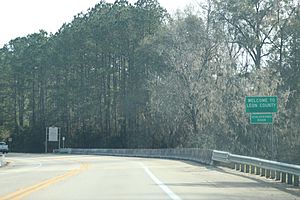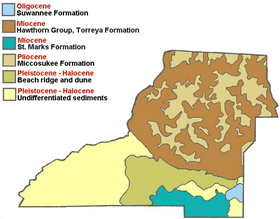Leon County, Florida facts for kids
Quick facts for kids
Leon County
|
|||
|---|---|---|---|

Leon County Courthouse
|
|||
|
|||
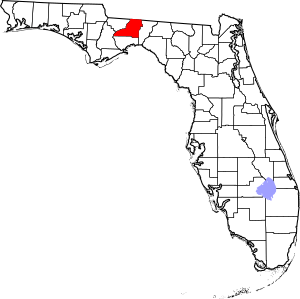
Location within the U.S. state of Florida
|
|||
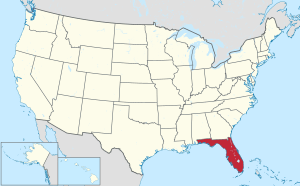 Florida's location within the U.S. |
|||
| Country | |||
| State | |||
| Founded | December 29, 1824 | ||
| Named for | Juan Ponce de León | ||
| Seat | Tallahassee | ||
| Largest city | Tallahassee | ||
| Area | |||
| • Total | 702 sq mi (1,820 km2) | ||
| • Land | 667 sq mi (1,730 km2) | ||
| • Water | 35 sq mi (90 km2) 5.0%% | ||
| Population | |||
| • Estimate
(2019)
|
293,582 | ||
| • Density | 435/sq mi (168/km2) | ||
| Time zone | UTC−5 (Eastern) | ||
| • Summer (DST) | UTC−4 (EDT) | ||
| Congressional districts | 2nd, 5th | ||
Leon County is a county in the Panhandle of the U.S. state of Florida. It was named after the Spanish explorer Juan Ponce de León. As of the 2010 census, the population was 275,487.
The county seat is Tallahassee, which is also the state capital and home to many politicians, lobbyists, jurists, and attorneys.
Leon County is included in the Tallahassee metropolitan area. Tallahassee is home to two of Florida's major public universities, Florida State University and Florida A&M University, as well as Tallahassee Community College. Together these institutions have a combined enrollment of more than 70,000 students annually, creating both economic and social effects.
Contents
History
Originally part of Escambia and later Gadsden County, Leon County was created in 1824. It was named after Juan Ponce de León, the Spanish explorer who was the first European to reach Florida. During the 1850s and 1860s, Leon County was a "cotton kingdom" and ranked fifth of all Florida and Georgia counties in the production of cotton from the 20 major plantations. Unique among Confederate capitals east of the Mississippi River in the American Civil War, Tallahassee was never captured by Union forces, and no Union soldiers set foot in Leon County until Reconstruction.
- Also see Plantations of Leon County.
Geography
According to the U.S. Census Bureau, the county has a total area of 702 square miles (1,820 km2), of which 667 square miles (1,730 km2) are land and 35 square miles (91 km2) (5.0%) are water. Unlike much of Florida, most of Leon County has rolling hills, part of north Florida's Red Hills Region. The highest point is 280 feet (85 m), located in the northern part of the county.
National protected area
- Apalachicola National Forest (part)
Bodies of water
- Lake Miccosukee
- Black Creek
- Lake Bradford
- Lake Ella
- Lake Hall
- Lake Iamonia
- Lake Jackson
- Lake Lafayette
- Lake Talquin
- Ochlockonee River
- Lake Munson
Adjacent counties
- Grady County, Georgia - north
- Thomas County, Georgia - northeast
- Jefferson County - east
- Wakulla County - south
- Gadsden County - west
- Liberty County - west
Transportation
Airports
- Tallahassee Commercial Airport
- Tallahassee International Airport
Major highways
 Interstate 10
Interstate 10 U.S. Highway 27
U.S. Highway 27 U.S. Highway 90
U.S. Highway 90 U.S. Highway 319
U.S. Highway 319 State Road 20
State Road 20 State Road 61
State Road 61 State Road 155
State Road 155 State Road 263
State Road 263 State Road 267
State Road 267 State Road 363
State Road 363
Geology
Leon County sits atop basement rock composed of basalts of the Triassic and Jurassic from ~251—145 million years ago interlayered with Mesozoic sedimentary rocks. The layers above the basement are carbonate rock created from dying foraminifera, bryozoa, mollusks, and corals from as early as the Paleocene, a period of ~66—55.8 Ma.
During the Eocene (~55.8—33.9 Ma) and Oligocene (~33.9—23 Ma), the Appalachian Mountains began to uplift and the erosion rate increased enough to fill the Gulf Trough with quartz sands, silts, and clays via rivers and streams. The first sedimentation layer in Leon County is the Oligocene Suwannee Limestone in the southeastern part of the county as stated by the United States Geological Survey and Florida Geological Survey.
The Early Miocene (~23.03—15.7 Ma) sedimentation in Leon County is Hawthorn Group, Torreya Formation and St. Marks Formation and found in the northern two-thirds of the county.
The Pliocene (~5.332—2.588 Ma) is represented by the Miccosukee Formation scattered within the Torreya Formation.
Sediments were laid down from the Pleistocene epoch (~2.588 million—12 000 years ago) through Holocene epoch (~12,000—present) and are designated Beach ridge and trail and undifferentiated sediments.
Terraces and shorelines
During the Pleistocene, what would be Leon County emerged and submerged with each glacial and interglacial period. Interglacials created the topography of Leon as it is known now.
Also See Leon County Pleistocene coastal terraces
Also see: Florida Platform and Lithostratigraphy
Geologic formations
- Red Hills Region (North)
- Cody Scarp (central)
- Woodville Karst Plain (South)
Demographics
| Historical population | |||
|---|---|---|---|
| Census | Pop. | %± | |
| 1830 | 6,494 | — | |
| 1840 | 10,713 | 65.0% | |
| 1850 | 11,442 | 6.8% | |
| 1860 | 12,343 | 7.9% | |
| 1870 | 15,236 | 23.4% | |
| 1880 | 19,662 | 29.0% | |
| 1890 | 17,752 | −9.7% | |
| 1900 | 19,887 | 12.0% | |
| 1910 | 19,427 | −2.3% | |
| 1920 | 18,059 | −7.0% | |
| 1930 | 23,476 | 30.0% | |
| 1940 | 31,646 | 34.8% | |
| 1950 | 51,590 | 63.0% | |
| 1960 | 74,225 | 43.9% | |
| 1970 | 103,047 | 38.8% | |
| 1980 | 148,655 | 44.3% | |
| 1990 | 192,493 | 29.5% | |
| 2000 | 239,452 | 24.4% | |
| 2010 | 275,487 | 15.0% | |
| 2020 | 292,198 | 6.1% | |
| U.S. Decennial Census 1790-1960 1900-1990 1990-2000 2010-2019 |
|||
Race
As of the census of 2010, there were 275,487 people, and 108,592 households residing in the county. The population density was 413.2 people per square mile (159.5/km2). There were 123,423 housing units at an average density of 185 per square mile (71.4/km2). The racial makeup of the county was 63.0% White, 30.3% Black or African American, 0.3% Native American, 2.9% Asian, 0.1% Pacific Islander, and 2.2% from two or more races. 5.6% of the population were Hispanic or Latino of any race.
Age
There were 108,592 households, out of which 24.2% had children under the age of 18 living with them, 36.9% were married couples living together, 13.1% had a female householder with no husband present, and 45.8% were non-families. 31.0% of all households were made up of individuals, and 6.1% had someone living alone who was 65 years of age or older. The average household size was 2.29 and the average family size was 2.92.
In the county, the population was spread out, with 20.0% under the age of 18, 26.3% from 18 to 24, 22.7% from 25 to 44, 22.4% from 45 to 64, and 8.7% who were 65 years of age or older. The median age was 27.8 years. For every 100 females, there were 91.57 males. For every 100 females age 18 and over, there were 89.03 males.
Education
The adult citizens of Leon County enjoy the highest level of education in the state of Florida followed by Alachua County with a total of 67.8%.
| Level of Education | ||||
|---|---|---|---|---|
| Level | Leon Co. | Florida | U.S. | |
|
|
||||
| Some college or associate degree | 28.5% | 28.8% | 27.4% | |
| Bachelor's Degree | 24.0% | 14.3% | 15.5% | |
| Master's or Ph.D. | 17.7% | 8.1% | 8.9% | |
| Total | 70.2% | 51.2% | 51.8% | |
Source of above:
Income
The median income for a household in the county was $37,517, and the median income for a family was $52,962. Males had a median income of $35,235 versus $28,110 for females. The per capita income for the county was $21,024. About 9.40% of families and 18.20% of the population were below the poverty line, including 16.20% of those under age 18 and 8.20% of those age 65 or over.
Accolades
- 2007 National Association of County Park and Recreation Officials: http://www.nacpro.org/' Environmental and Conservation Award for exceptional effort to reclaim, restore, preserve, acquire or develop unique and natural areas. Leon County has 1,300 acres (5.3 km2) of open space, forest and woodlands between the Miccosukee Canopy Road Greenway and J.R. Alford Greenway.
Points of interest
- Alfred P. Maclay Gardens State Park
- Apalachicola National Forest
- Birdsong Nature Center
- Bradley's Country Store Complex
- Florida State Capitol
- Florida Supreme Court
- Florida State Archives
- Florida Vietnam War Memorial
- Lake Jackson Mounds Archaeological State Park
- Leon County Fairgrounds
- Leon County's 5 canopy roads
- Mission San Luis de Apalachee
- Museum of Florida History
- Old Fort Park
- Tall Timbers Research Station
- Tallahassee Antique Car Museum
- Tallahassee Museum
- Tallahassee-St. Marks Historic Railroad Trail State Park
Paleontology
Three sites within Leon County have yielded fossil remnants of the Miocene epoch. The article Leon County, Florida paleontological sites includes the Griscom Plantation Site, Seaboard Air Line Railroad Site, and Tallahassee Waterworks Site with fossils by genus and species.
Communities
City
Census-designated place
Other unincorporated communities
- Baum
- Black Creek
- Bloxham
- Bradfordville
- Capitola
- Centerville
- Chaires
- Chaires Crossroads
- Felkel
- Fort Braden
- Gardner
- Iamonia
- Ivan
- Lafayette
- Lutterloh
- Meridian
- Miccosukee
- Ochlockonee
- Rose
- Wadesboro
Defunct entity
- Bond-South City, a former census-designated place enumerated by the United States Census Bureau in 1950 & 1960.
Education
Higher education
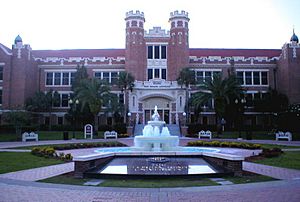
Florida State University
Florida State University (commonly called Florida State or FSU) is an American public space-grant and sea-grant research university. It has a 1,391.54-acre (5.631-km2) campus in Tallahassee. In 2017, it had nearly 42,000 students. It is a senior member of the State University System of Florida. Founded in 1851, it is on Florida's oldest continuous site of higher education.
The university is classified as a Research University with Very High Research by the Carnegie Foundation for the Advancement of Teaching. It comprises 16 separate colleges and more than 110 centers, facilities, labs and institutes that offer more than 360 programs of study, including professional school programs. The university has an annual budget of over $1.7 billion. Florida State is home to Florida's only National Laboratory, the National High Magnetic Field Laboratory, and is the birthplace of the commercially viable anti-cancer drug Taxol. FSU also operates the John & Mable Ringling Museum of Art, the State Art Museum of Florida and one of the nation's largest museum/university complexes.
FSU is accredited by the Southern Association of Colleges and Schools (SACS). It is home to nationally ranked programs in many academic areas, including law, business, engineering, medicine, social policy, film, music, theater, dance, visual art, political science, psychology, social work, and the sciences. FSU leads Florida in four of eight areas of external funding for the STEM disciplines.
For 2019, U.S. News & World Report ranked Florida State the country's 26th-best public university.
Florida Governor Rick Scott and the state legislature designated FSU one of two "preeminent" state universities in the spring of 2013 among the 12 universities of the State University System of Florida.
FSU's intercollegiate sports teams, commonly called the Seminoles, compete in National Collegiate Athletic Association (NCAA) Division I and the Atlantic Coast Conference (ACC). The athletics programs are favorites of passionate students, fans and alumni across the country, especially when led by the Marching Chiefs of the Florida State University College of Music. In their 113-year history, the Seminoles have won 20 national athletic championships and Seminole athletes have won 78 individual NCAA national championships.
Florida A&M University
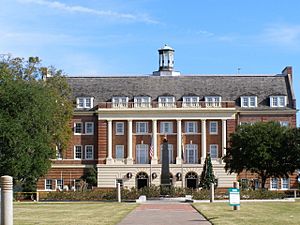
Founded on October 3, 1887, Florida A&M University (FAMU) is a public, historically black university that is part of the State University System of Florida and is accredited by the Southern Association of Colleges and Schools. FAMU's main campus comprises 156 buildings spread over 422 acres (1.7 km2) on top of Tallahassee's highest geographic hill. In 2016 it had more than 9,600 students. FAMU also has several satellite campuses. Its College of Law is at its Orlando site, and its pharmacy program has sites in Miami, Jacksonville and Tampa. FAMU offers 54 bachelor's degrees and 29 master's degrees. It has 12 schools and colleges and one institute.
FAMU has 11 doctoral programs, including ten Ph.D. programs: chemical engineering, civil engineering, electrical engineering, mechanical engineering, industrial engineering, biomedical engineering, physics, pharmaceutical sciences, educational leadership, and environmental sciences. Top undergraduate programs are architecture, journalism, computer information sciences, and psychology. FAMU's top graduate programs include pharmaceutical sciences, public health, physical therapy, engineering, physics, master's of applied social sciences (especially history and public administration), business, and sociology.
Tallahassee Community College
The Florida Legislature founded Tallahassee Community College in 1966. TCC is a member of the Florida College System. It is accredited by the Florida Department of Education and the Southern Association of Colleges and Schools. Its primary site is a 270-acre (1.092 km2) campus in Tallahassee.
TCC offers Bachelor's of Science, Associate of Arts, Associate of Science, and Associate of Applied Sciences degrees. In 2013, it was 1st in the nation in graduating students with A.A. degrees. TCC is also the nation's #1 transfer school to Florida State University. As of 2015, TCC had 38,017 students.
In partnership with Florida State University, TCC offers the TCC2FSU program. This program provides guaranteed admission to FSU for TCC Associate in Arts degree graduates.
List of other colleges
- Barry University School of Adult and Continuing Education – Tallahassee Campus
- Embry-Riddle Aeronautical University
- Flagler College – Tallahassee Campus
- Keiser University – Tallahassee Campus
- Lewis M. Lively Area Vocational-Technical School
- Saint Leo University – Tallahassee Campus
Primary and secondary education
The Leon County School District administers and operates Leon County's public schools. LCS is operated by a superintendent, 5 board members, and 1 student representative. There are 25 elementary schools, 10 middle schools, seven high schools, eight special/alternative schools, and two charter schools.
List of middle schools
- Cobb Middle School
- Deerlake Middle School
- Fairview Middle School
- Fort Braden School K - 8
- Governor's Charter Academy (Charter K–8)
- Griffin Middle School
- Holy Comforter Episcopal School (Private PK3–8)
- Maclay School (Private PK3–12)
- Montford Middle School
- Nims Middle School
- Raa Middle School
- Success Academy of Tallahassee
- Swift Creek Middle School
- Stars Middle School (Charter)
- School of Arts and Sciences (Charter K–8)
- Tallahassee School of Math and Science (Charter K–8)
- Trinity Catholic School (Private PK3–8)
- Cornerstone Learning Community (Private PK3–8)
List of high schools
- Amos P. Godby High School
- Atlantis Academy
- Community Christian School
- Florida A&M University Developmental Research School
- Florida State University High School
- James S. Rickards High School
- John Paul II Catholic High School
- Lawton Chiles High School
- Leon High School
- Lincoln High School
- Lively Technical Center
- Maclay School
- North Florida Christian High School
- SAIL High School
- Woodland Hall Academy
Libraries
Leon County operates the Leroy Collins Leon County Public Library, with 7 branches serving the county:
- Leroy Collins Main Library
- Northeast Branch Library
- Eastside Branch Library
- Dr. B.L. Perry, Jr. Branch Library
- Lake Jackson Branch Library
- Woodville Branch Library
- Jane G. Sauls Fort Braden Branch Library
The Leon County Public Library was renamed in 1993 to honor LeRoy Collins, the 33rd governor of Florida.
History of library services
The Carnegie Library of Tallahassee provided library services to the black community before desegregation. It was the first and only public library in Tallahassee until 1955. Philanthropist Andrew Carnegie offered Tallahassee money to build a public library in 1906. According to Africology: The Journal of Pan African Studies, the library was built on the FAMU campus because the city refused the donation because it would have to serve the black citizens. "The facility boasted modern amenities such as electricity, indoor plumbing and water supplied by the city. In later years, the Library served as an art gallery, religious center, and in 1976, became the founding home of the Black Archives Research Center and Museum. By functioning both as a repository for archival records and a museum for historical regalia, the center continues to render academic support to educational institutions, civic, political, religious and Museum. By functioning both as a repository for archival records and a museum for historical regalia, the center continues to render academic support to educational institutions, civic, political, religious and social groups, as well as, public and private businesses throughout Florida and the nation." The building was designed by noted architect William Augustus Edwards and was built in 1908. On November 17, 1978, it was added to the U.S. National Register of Historic Places.
The Carnegie Library of Tallahassee, which served only the black community, became the only free public library in the city until 1955. According to the Leon County Public Library's website, the American Association of University Women formed the Friends of the Library organization in 1954. The formation of the Friends of the Library was in direct response to the fact that "Tallahassee was the only state capital in the United States not offering free public library service." A year later, the library was established by legislative action and developed by citizens and civic groups. The first Leon County free public library opened on March 21, 1956. The first building to house the library was The Columns, one of the oldest remaining antebellum homes in the Leon County area, at Park Avenue and Adams Street (now the home of the James Madison Institute).
In order to expand library services, the Junior League of Tallahassee donated a bookmobile to the library. The vehicle was later donated to the Leon County Sheriff's Office to be used as a paddywagon for its Road Prison. In 1962, the library moved to the old Elks Club building at 127 North Monroe Street. Public transit in the city of Tallahassee had been desegregated by 1958, but the public library system was only integrated several years later.
In the early 1970s, Jefferson and Wakulla Counties joined the Leon County Public Library System, forming the Leon, Jefferson, and Wakulla County Public Library System. According to the library's website, "Leon County provided administrative and other services to the two smaller counties, while each supported the direct costs of their library services and their share of Leon's administrative costs." In 1975 the system started a branch library in Bond, a predominantly black community on the city's south side. Wakulla County left the library cooperative in 1975 to start its own library system and in 1978 the main library moved to Tallahassee's Northwood Mall. Jefferson County left the library cooperative in 1980 and the library reverted to the Leon County Public Library. In 1989, "ground breaking was held on March 4 for a new $8.5 million main library facility with 88,000 feet of space. The site was next door to the library's original home, The Columns, which had been moved in 1971 to 100 N. Duval." The new library had its grand opening in 1991 and was renamed in 1993 in honor of former Governor LeRoy Collins.
Notable people
- Wally Amos – founder of the "Famous Amos" chocolate chip cookie brand; actor
- Tony Hale – actor, played Byron "Buster" Bluth on Arrested Development
- Isaac Jenkins (1846-1911), politician who served in the Florida House of Representatives in the 1880s
- Jerrie Mock – aviator and first woman to fly around the world solo
- T-Pain (born Faheem Najm) – hip hop and R&B singer
- Ernest I. Thomas – raiser of the original flag at Iwo Jima
See also
 In Spanish: Condado de León (Florida) para niños
In Spanish: Condado de León (Florida) para niños




